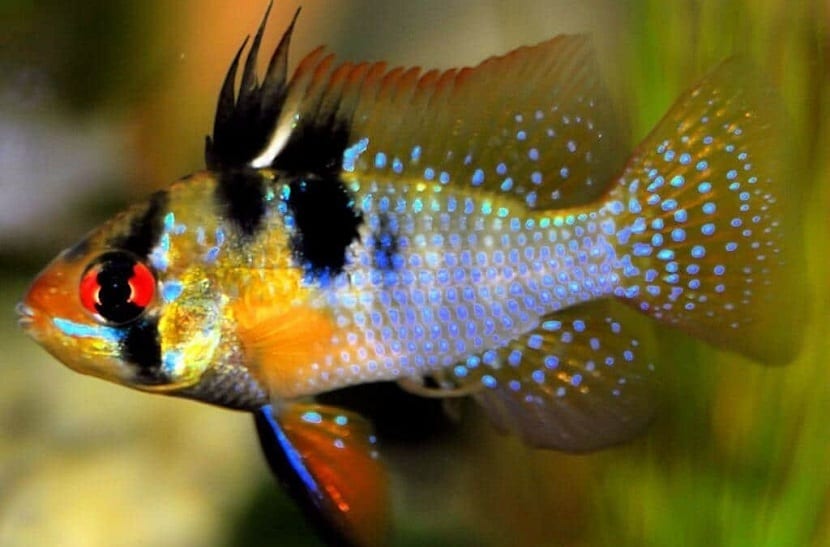
Today we are going to talk about a type of fish for our aquarium that comes from South America, Colombia and Venezuela. Its about Ramirez's Dwarf Cichlid fish (Papiliochromis Ramirezi o Microgeophagus ramirezi).
These fish are quite showy and colorful although they can have some behavioral problems compared to the other fish you have in the aquarium. Do you want to know everything about these fish for your aquarium?
Ramirezi data
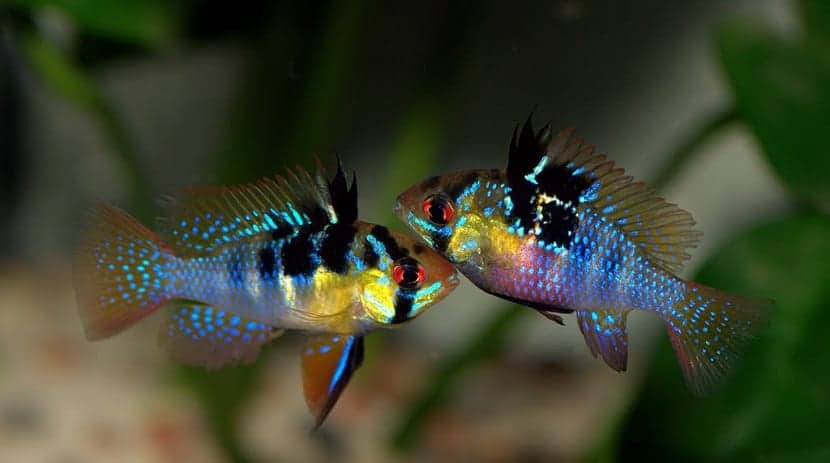
These fish belong to the order of the perciformes and the cichlid family. This fish has quite inferior swimming abilities compared to other fish. They are quite territorial, but they are not violent.
Regarding its appearance, it is a fairly stylized fish with an intense color and they have a lot of character among members of the same species. It is an extremely sensitive fish to chemical variations in the water (such as pollution). This makes the maintenance of the fish somewhat complicated, since the quality of the water in which it lives must be monitored very carefully and frequently. The life of this fish is quite short: it usually only lasts 2 to 3 years.
Ramizeri characteristics

The body of the ramizeri is yellow with some vertical black or brown stripes. Some have spots all over their bodies and are blue in color. One feature that distinguishes them from the rest is that they have a vertical black stripe that crosses the eye. The fish is about 7,5 cm long.
The dorsal fin of these fish is higher at the beginning and at the end, unlike in other fish. When the fin reaches the end it takes the shape of a plume with the first three black. Sexual dimorphism is poorly defined in Papiliochromis Ramirezi, it is not as large as in other dwarf cichlids. Generally females Microgeophagus Ramirezi they are smaller than the males and with a pink belly.
Not all ramirezi fish are the same color. There are different varieties among which we find the golden ones, the albinos, others have fins with different shapes, although the most abundant variety is the wild one.
Behavior and compatibility
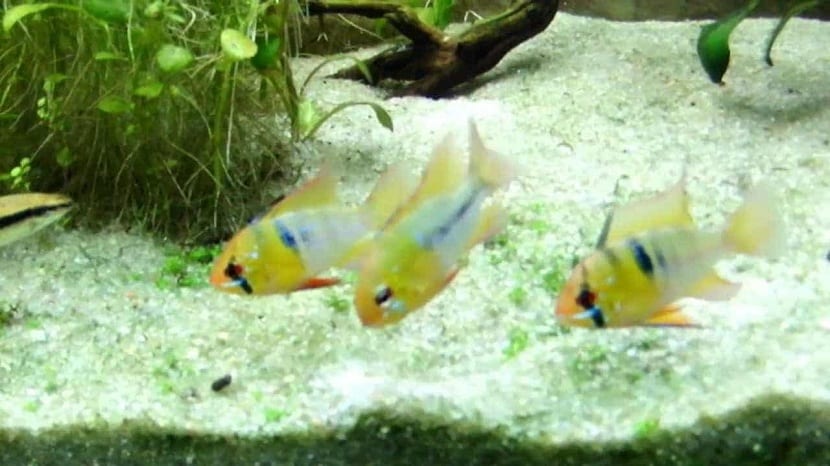
These fish, as mentioned before, are quite territorial, although they are peaceful. Ideally, keep a pair in small aquariums and associate them with other small fish of higher range. Although they are territorial, they do not present aggressiveness, but they are usually kept in their refuge, taking some infrequent walks in the lower and middle part of the aquarium. They do not usually rise to the surface, except for when they feed.
The time when they behave in a more territorial way is when they have young, like most cichlids. As has been said before, one of the characteristics that make it special is that within the cichlid family, it is one of the least long-lived. They only last two or three years. It must be borne in mind that when they are purchased in a store, they are already at least one year old, so the duration of these fish in the aquarium is shorter.
To differentiate males from females we must note that females they are normally somewhat smaller than males and have a more rounded body. In addition, the first rays of the dorsal fin are longer in males.
Ramizeri natural habitat

These fish originate from the Central Orinoco between Colombia and Venezuela. In these rivers there are usually a lot of vegetation and shady areas with the singularity that they are found in places where there is space to swim. If we want to have them in an aquarium, we must prepare it with logs and stones that allow it to mark a territory to which they are used in the wild.
It must be remembered that this species is quite sensitive to changes in temperature and chemical composition of the water. So if the aquarium temperatures change or it begins to become contaminated by filter failures or external agents, these fish will start to suffer damage.
Needs in the aquarium
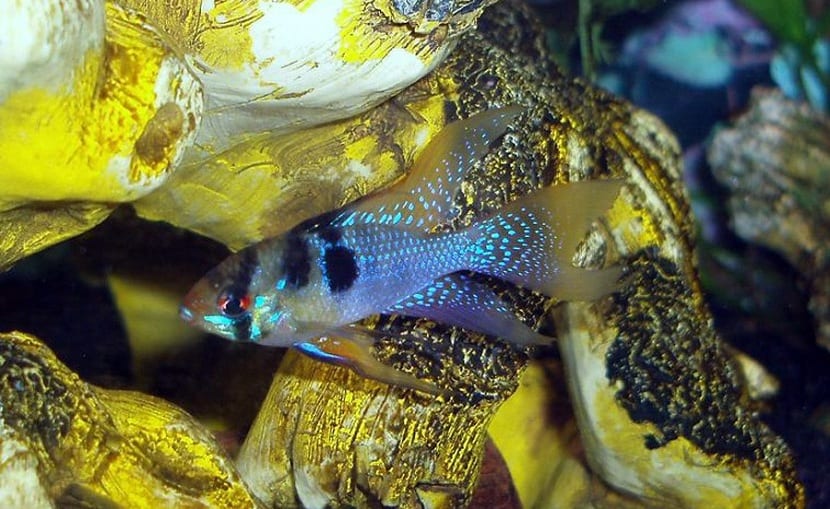
For these fish to be able to live in adequate conditions, a water volume of approximately 40 liters for each pair. Since males are more aggressive than females and delimit a larger territory, such a volume of water is necessary. In order for the females to feel more protected, a hiding place should be set up for each female in each territory. In addition, these hiding places are more efficient if they are distributed throughout the aquarium.
On the other hand, these fish are very sensitive to nitrate concentrations in the environment and they cannot live with concentrations of 10mg / l. This is important to take into account if we have natural plants in the aquarium and we want to pay them.
Once the pairs are formed, they will defend the territory together, so the male will not behave as aggressive.
It is advisable to place a dense plantation in the periphery, and low plants in terraces in the center of the aquarium, caves and hiding places formed by rocks, logs and roots.
Reproduction
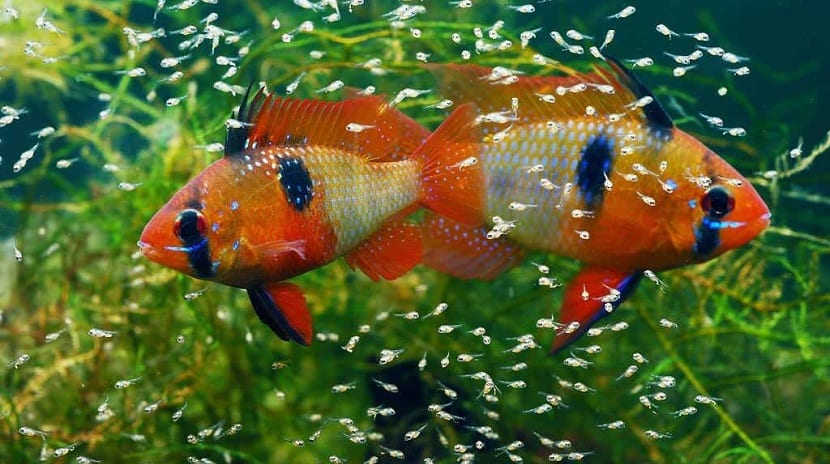
Ramirezi are monogamous fish, that is, they pair with a single female and stay together with her, and vice versa. Reproduction is similar to that of other cichlids. It consists of the delimitation of a territory that the two defend (the male always acts in a more aggressive way and tries to protect more land). They will only be violent when another fish gets too close to your territory. Within the territory they delimit, they place an ideal place to place the eggs. To do this, they prepare the place by placing a flat rock, a set of rocks, or dig a hole to have gravel to protect the eggs. The place for laying will be meticulously cleaned, after which the female will deposit rows of adhesive eggs that the male will fertilize immediately. Although breeding can take place in a community aquarium, a specific tank is preferable. To force the breeding we must place the Ph below 7 around 6,5, values that you can check with a water quality meter of the aquarium.
The volume of water that this tank requires for the hatchlings and the couple it is about 50 liters. An ideal place for the care of the young will be prepared and the rest of the aquarium will be left free for them to swim. The water temperature will be 26 ° - 27 ° C. Both parents take care of the laying, but there is a risk that they will devour the eggs, and since parental care is not essential for reproductive success, they can be removed if desired.
The female can deposit between 300 and 400 eggs, although not all are born or survive. Once the eggs are laid, they take about 4 days to hatch. At 8 days, yolk sac reabsorption occurs and the fish can be fed brine shrimp nauplii. As the fry begin to feed they will become more independent until the parents stop caring for them, at this time it is possible that they are ready for a new spawn.
As the fry grow, they can be given other foods such as crushed red mosquito larvae, some encapsulated foods and powdered foods. Lthe fry grow slow, since its life is short and almost a third of it are fry.
For the fry to develop better and in good condition, the water must be free of nitrites and nitrates. Also, to make them grow faster, they can be fed more frequently, but less. Males grow faster than females, basically because they also reach a larger adult size.
Differences between the sexes

The males have a much more intense color than the females as well as a greater size. The second radius of the dorsal fin is usually longest among males. Females are usually distinguishable by the redness of the abdomen and having a more rounded body (Among young specimens it is very difficult to distinguish them). Before spawning the female is recognized by a short ovipositor.
Food and prices
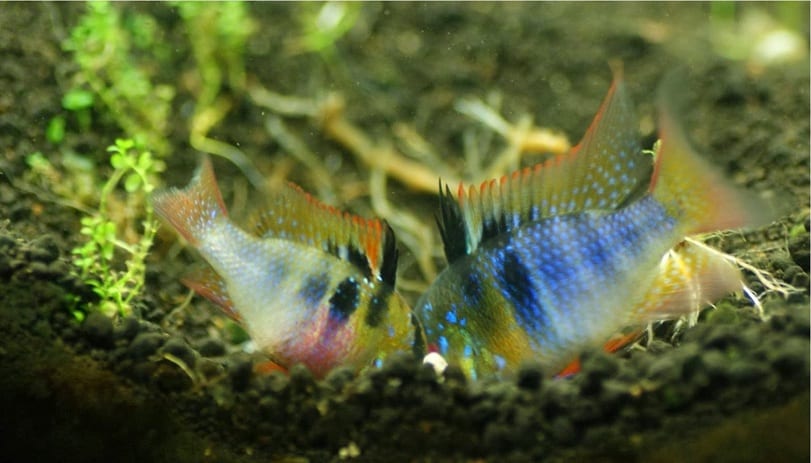
For the feeding it is not necessary to complicate much, since these fish eat practically everything. You can give it scales, frozen, live foods ... The variety of foods they eat it will influence their growth, development and behavior.
Its purchase price in stores is around 6 euros. The younger and more colorful it is, the higher the price. The golden ramirezi they cost 50 euros, but since you can only have one partner, it is not very expensive.
As you can see, these fish are quite special and unique to buy in our aquarium. Various factors must be taken into account, such as the temperature of the aquarium, the chemical characteristics of the water (avoid contamination, clean the filters periodically, and use cleaner fish), and the territoriality of these fish. If they feel threatened or other more peaceful and friendly fish approach their conditioned area to their laying area, they will attack them.
For the rest of the characteristics, these colorful and peaceful fish are ideal for our aquarium and to give it a colorful and unique touch.
The truth is that it is very good and very synthetically commented, it was very useful for me. The only thing I would add to make it perfect is the species that share the natural territory and can be shared by the aquarium with the ramirezi ...
I would very much like you to answer my question / concern!